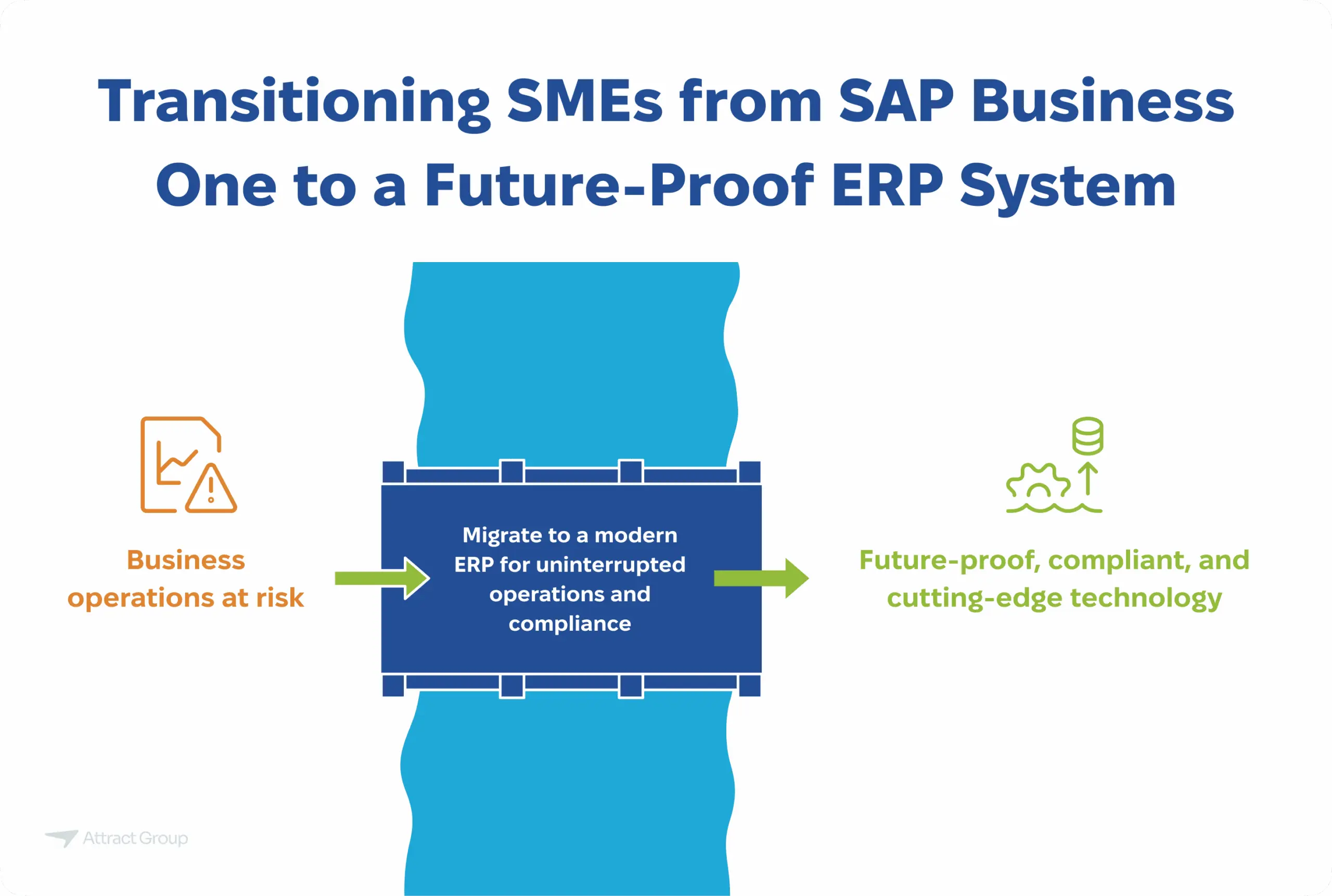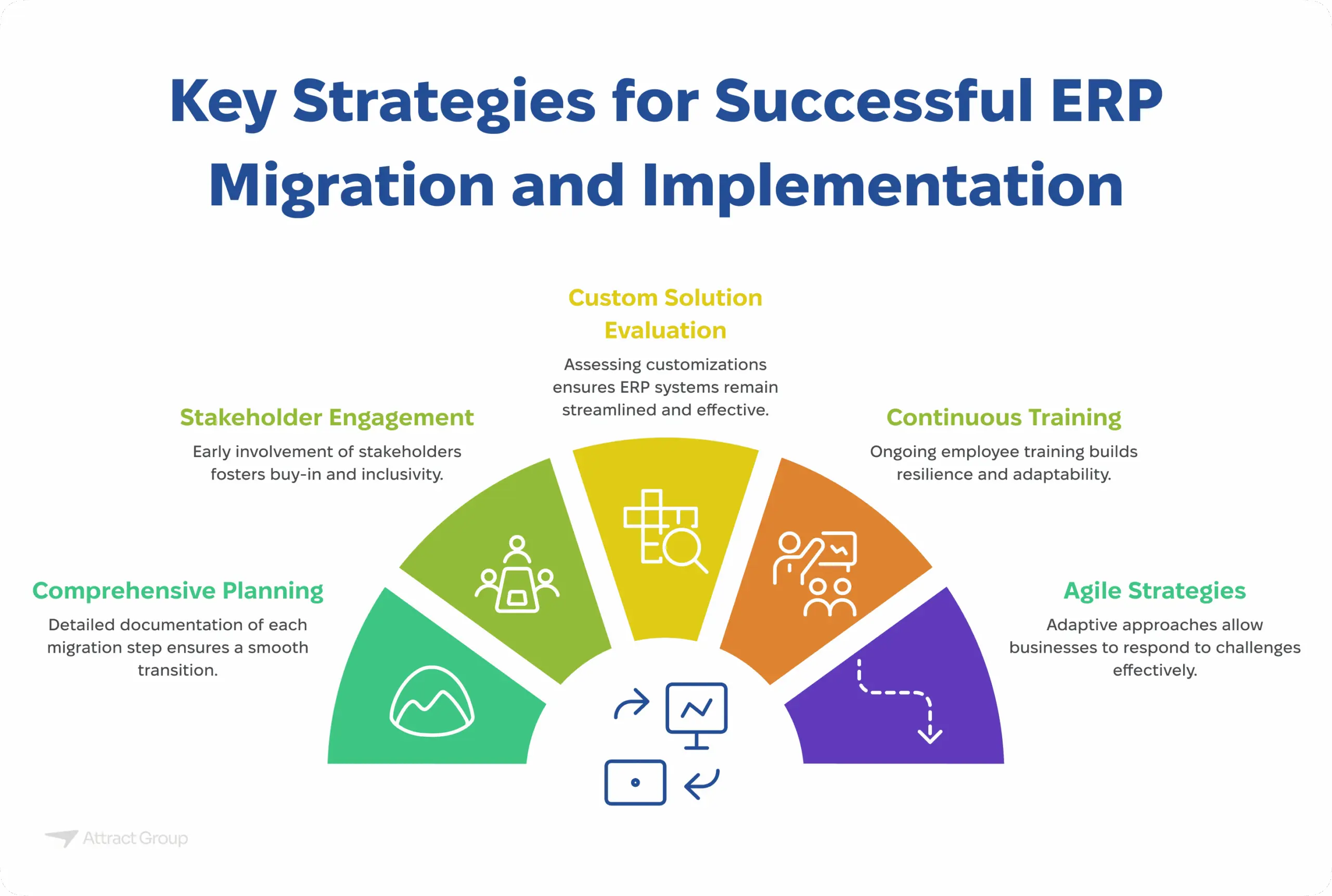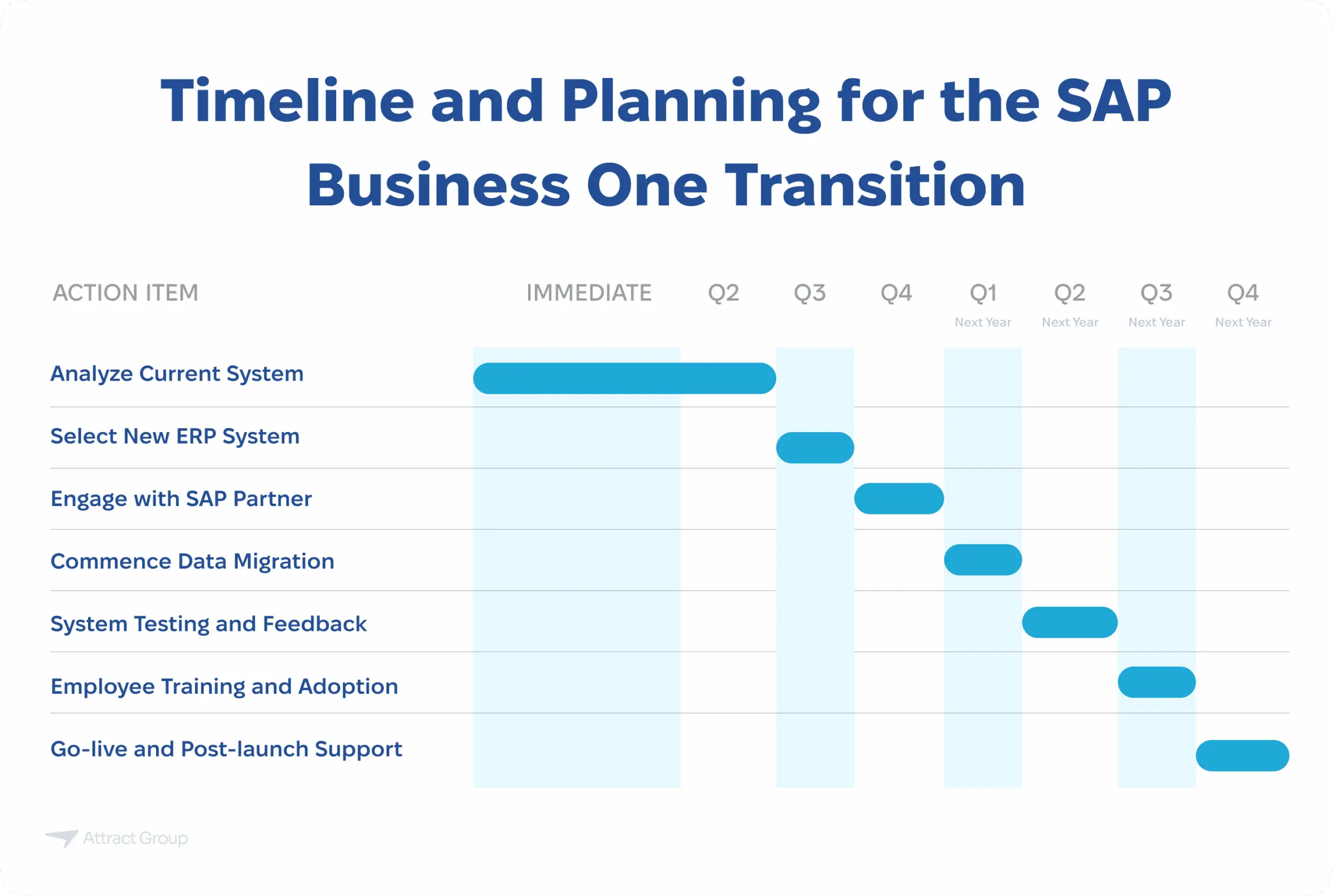Navigating the SAP Business One Discontinuation
 28 May 2024
28 May 2024? Listen to the Summary of this article in Audio
For businesses leveraging SAP Business One, the announcement of its discontinuation presents critical considerations for operational continuity and strategic planning. The end-of-life phase for this pivotal enterprise resource planning system signals a transformative period for small and medium-sized enterprises (SMEs) that have relied on its capabilities for streamlined business processes. Facing the SAP Business One end of life scenario, companies are now tasked with assessing how best to transition into the future, safeguarding uninterrupted operations, compliance, and access to cutting-edge technology within their industry. With an eye on SAP Business One future prospects, it’s vital for these businesses to understand the implications of the discontinuation and to chart a course for a seamless transition.

Key Takeaways
- Mainstream support for SAP Business One Release 10.0 will persist until December 31, 2026, providing a timeframe for transition.
- Post the support period, businesses must upgrade or seek alternatives to avoid potential operational disruptions.
- Compliance with current legislation and continuous support hang in the balance, necessitating strategic action.
- Insight into the SAP Business One roadmap is essential for planning beyond the discontinuation period.
- Future-proofing business operations is key, including exploring new software and service solutions available.
- No extended maintenance is offered, underscoring the urgency for an effective sap business one transition plan.
Introduction to SAP Business One and Its Market Impact
For over two decades, SAP Business One has carved its niche as an indispensable resource planning tool for small and medium-sized enterprises (SMEs), deeply embedding itself into the very fabric of their daily operations. Distinguished by its robust features that align with the dynamic needs of various industries, SAP Business One has served as a beacon of innovation and evolution within the ERP landscape.
Overview of SAP Business One and Its Role in SMEs
SAP Business One gained prominence among SMEs due to its capability to aggregate various facets of business management—finance, sales, customer relations, inventory, and operations—into a unified, accessible interface. The incorporation of industry-specific tools has enabled SMEs to not only streamline processes but also ensure strict adherence to legislative compliance, asserting its role as a multifaceted enabler of daily commercial activity.
Timeline of SAP Business One Development and Discontinuation
The developmental trajectory of SAP Business One has been marked by regular updates and feature enhancements, with the notable SAP Business One 10.0 release in April 2020 serving as the latest milestone. Since this major release, SAP has followed a strategy of rolling out continuous innovation through periodic feature packages, allowing users to leverage the latest functionalities without disrupting the existing user interface. As part of the SAP Business One release family, these expansions have fortified the ERP system’s relevance and utility.
However, the course of technology is ever-revolving, and as indicated in the SAP Business One roadmap, significant shifts are forthcoming. With the end of the mainstream maintenance for Release 10 scheduled for December 31, 2026, and the anticipation of Version 11, the roadmap underscores the pressing need for businesses to familiarize themselves with the SAP Business One support policy. This impending transition obliges companies to explore SAP Business One software alternatives and seek out other SAP Business One solutions that align with the impending evolution of their commercial ecosystems. Consequently, enterprises must now diligently assess their strategies to ensure uninterrupted operations well into the future.

Understanding the Reasons Behind SAP Business One Discontinuation
The landscape of enterprise resource planning (ERP) is experiencing a significant shift as SAP Business One approaches the end of its lifecycle for certain releases. Understanding the reasons behind this change, its implications, and the subsequent impact on current users is essential for businesses that depend on this software for their day-to-day operations. Strategic planning for sap business one migration strategies, sap business one replacement, and sap business one upgrade options have become more critical than ever.
The Official Announcement and Its Implications
SAP’s official announcement of the discontinuation of mainstream maintenance for earlier versions of SAP Business One, such as the 8.8/8.81/8.82 and the 9.0/9.1/9.2/9.3 release families, marked the inception of a new phase of SAP’s maintenance strategy. With no extended maintenance offered, the release family of version 10.0, with mainstream support until December 31, 2026, now becomes a critical feature of planning for your business’s IT future. This decisive move by SAP cements the need for an active sap business one upgrade strategy to remain within the bounds of supported technology.
Impact on Current Users of SAP Business One
Current users are hit most directly by the termination of support for older SAP Business One releases. With extended support being off the table, companies must reimagine their system infrastructure to continue benefiting from SAP’s support services, security updates, and compliance standards. For businesses that hitherto relied on older releases, this means an inevitable journey towards either an upgrade within the SAP ecosystem or exploring different sap business one replacements. Evidently, initiating timely and well-informed sap business one migration strategies becomes the cornerstone for seamless business continuity and growth.
- Can existing customizations be retained? Traversing from one SAP Business One version to another or to a completely different ERP system often raises questions about the transferability of custom features.
- Are there adjacent technologies to integrate during migration? Considering whether to incorporate new technologies during the migration process is another pivotal decision, as it may yield transformative business improvements.
- How can disruption to operations be minimized? Any transition strategy needs to be as smooth as possible to avoid significant downtime or disruption, thus ensuring the continuity of operations.

Overall, the discontinuation of SAP Business One’s earlier releases underscores a pressing need for current users to engage with the sap business one upgrade options anew, ensuring that their business’s backbone — the ERP system — remains robust and future-ready.
Our experts make switching from SAP Business One to a custom ERP a breeze. Get the perfect solution for your business needs!

Exploring Alternatives and Solutions
As SAP Business One evolves and faces the discontinuation of support for certain components, businesses using this system are at a crossroads. The changing landscape requires a look beyond the traditional SAP Business One ecosystem, prompting organizations to establish a transition towards either cloud-based alternatives or other SAP solutions. It is imperative to consider a comprehensive sap business one migration to ensure operational efficiency, and seamless integration with contemporary technologies. Let’s delve into various options and develop an understanding of the opportunities, as well as the challenges they may present.
Transitioning to Other SAP Solutions: Opportunities and Challenges
For many, the first instinct is to look within the SAP suite of offerings for a sap business one upgrade. SAP’s extensive portfolio of ERP solutions provides various routes for users to transition from Business One. The transition to SAP S/4HANA, for instance, represents a significant shift towards a more powerful, analytics-driven platform that could elevate operational prowess. However, with such a transition comes the challenge of scaling the solution to fit SME needs and managing the associated costs of this higher-end ERP system.
The Role of Custom Solutions Post-Discontinuation
Custom solutions tailored to specific business requirements can act as a sap business one alternative, especially in industries with niche operational demands. While custom development offers the flexibility to maintain and enhance legacy processes that may have been a part of a company’s success, such bespoke options require substantial investment in both time and resources for development and maintenance, posing a critical decision for resource allocation.
Migrating to Cloud-Based ERP Systems
Another viable path lies in the adoption of cloud-based ERP systems which offer a cost-effective, scalable platform for business management. Migrating to a cloud-based system facilitates remote access to data, enhanced security, and decreased dependency on physical infrastructure. For perpetual license holders of Business One, the transition can mean continued operation without substantial disturbance, whereas subscription-based users will need to address this change before their term concludes. A strategic sap business one migration, when executed correctly, has the potential to streamline business workflows and foster innovation within the organization.
| Consideration | Opportunity | Challenge |
|---|---|---|
| SAP S/4HANA Transition | Access to advanced analytics and real-time data processing. | Cost and scalability for SMEs may be prohibitive. |
| Custom Solutions | High degree of customization for unique business needs. | Requires significant ongoing development and upkeep. |
| Cloud-Based ERP Migration | Scalable, cost-effective, and enhances business agility. | Requires careful planning and potentially complex data migration. |
In evaluating sap business one replacement solutions, businesses must not only consider the functional fit but also the growth trajectory of their operations. Exploring a blend of off-the-shelf and tailored solutions can pave the way for a robust, future-ready infrastructure that leverages the latest in ERP advancements while staying aligned with the unique essence of the business.
Discover the benefits of a bespoke ERP system designed to streamline your operations, enhance efficiency, and drive growth for your business.
Developing a Migration Strategy for Your Business
With SAP Business One reaching the end of its lifecycle for certain releases, organizations are prompted to develop robust sap business one migration strategies. Scenarios demanding a transition from SAP Business One to alternative solutions are no small feat and need strategic foresight. The following paragraphs outline the critical components required for crafting a migration strategy that mitigates risk while maximising operational continuity and compliance.
Key Considerations When Choosing a New ERP System
While SAP’s discontinuation of certain Business One components ushers in a period of transition, it also provides an opportunity for businesses to realign their technological infrastructure with their operational goals. The selection of a new ERP system should be informed by a series of strategic factors:
- Operational efficiency: The new system must ensure a seamless flow of day-to-day business activities.
- Regulatory compliance: It is imperative to maintain compliance with industry standards and legislation.
- Support and maintenance: Establishing a line to continuous and competent sap business one support is vital in troubleshooting potential system standstills.
- Product roadmap alignment: The chosen solution should align with the long-term strategic direction of the business.

Steps for a Smooth Transition from SAP Business One
Executing an orderly transition from an established ERP like SAP Business One requires a meticulous approach. Certain steps can streamline the process:
- Evaluate the current system and processes to determine core requirements and functionalities that the new ERP should replicate or enhance.
- Assess and document every integration point to ensure the new system supports existing workflows or provides a pathway to updated processes.
- Develop a comprehensive sap business one upgrade strategy, inclusive of timelines for feature delivery and deployment milestones.
- Engage with stakeholders across the organization to facilitate input and buy-in for the new system.
- Plan resource allocation effectively, considering budget constraints and personnel needs during and post-migration.
- Test the new system thoroughly to guarantee operational capabilities from day one.
- Provide ample training and resources to employees to ease the adoption of the new ERP system.
Leveraging Support and Resources During the Transition
Transitioning to a new ERP solution is not an isolated task but a collaborative effort that benefits from external support and expertise. Businesses should be proactive in:
- Engaging early with SAP partners to navigate the complexities of the transition and reduce maintenance costs through expert consulting.
- Understanding the maintenance and support packages offered by the new ERP vendor, including 24×7 support provisions for critical issues.
- Leveraging available resources, such as whitepapers, community forums, and training workshops, to become acquainted with the functionalities of the potential replacement system.
A structured migration strategy, underpinned by the right mix of planning, partner engagement, and resource utilization, forms the linchpin of a business’s pivot from SAP Business One to its new ERP home. This approach crystalizes the roadmap for businesses as they recalibrate their systems in alignment with the future digital landscape.
Case Studies: Success Stories of Transitioning from SAP Business One
Navigating through the ever-evolving enterprise resource planning (ERP) landscape, multiple businesses have carved out their own sap business one success stories. Through meticulous planning and strategic executions, these organizations have not only coped with but thrived following their SAP Business One migration. Their journeys illuminate a path laden with cautionary tales and best practices, which serve as beacons for other businesses on the cusp of digital transformation.
Lessons Learned and Best Practices
In reviewing various success stories, common threads of best practices emerge, informing an effective transition strategy.
- Comprehensive Transition Planning – Companies that document every step of their transition process, from software selection to post-go-live support, tend to navigate the migration more smoothly.
- Stakeholder Engagement – Involving stakeholders from across the operation spectrum early on cultivates buy-in and facilitates a more inclusive migration journey.
- Custom Solution Evaluation – Assessing the necessity and scalability of customizations ensures that new ERP systems remain streamlined and effective.
- Continuous Training Initiatives – Companies that invest in ongoing employee training create resilient workforces capable of adapting to new systems rapidly.
- Agile Adoption Strategies – Adaptive strategies allow businesses to respond to unanticipated challenges during migration, maintaining operational agility.

These best practices are not just strategies but cultural shifts that can greatly influence the success of migrating to a new ERP system.
How Businesses Thrived Post-Migration
The agility and foresight demonstrated during migration can lead to thriving post SAP Business One migration, with organizations often realizing significant performance improvements.
- Realized Cost Efficiencies – Businesses report a considerable reduction in overheads due to the increased efficiency and automation of new ERP systems.
- Enhanced Data Accessibility – Improved data visibility and analytics supports more informed decision-making across departments.
- Operational Resilience – Streamlined workflows and adaptable infrastructure contributes to robust operational resilience.
- Compliance and Security Assurance – A renewed commitment to compliance and data security post-transition fortifies business integrity.
- Innovation and Growth – Access to cutting-edge technology fosters an environment conducive to innovation and strategic growth.
The mark of a truly successful ERP system migration lies not just in the preservation of operational stability but in positioning the business to capitalize on new opportunities for growth and innovation. As seen in these compelling sap business one success stories, organizations continue to flourish, harnessing the promise of new ERP horizons.
Proposed Timeline and Planning for the Transition
Planning SAP Business One transition should start well ahead of the discontinuation date. Develop a roadmap that outlines critical milestones and timelines for migration to ensure your business maintains continuity. Include time for system analysis, data migration, testing, and workforce training within the transition plan. Collaborating with an active SAP partner can further streamline the process and minimize disruption.
| Action Item | Expected Outcome | Timeframe |
|---|---|---|
| Analyze Current System | Identification of essential features and workflows to carry over | Immediate – Q2 |
| Select New ERP System | Decision on ERP system aligning with business needs | Q3 |
| Engage with SAP Partner | Expert guidance on transition strategy and execution | Q4 |
| Commence Data Migration | Secure transfer of data to the new system | Q1 next year |
| System Testing and Feedback | Ensuring full operability and addressing any issues | Q2 next year |
| Employee Training and Adoption | Workforce readiness for the new system | Q3 next year |
| Go-live and Post-launch Support | Seamless transition and responsive support system | Q4 next year |
Through proactive planning and adherence to a strategic timeline, your business can tackle the SAP Business One discontinuation with confidence, securing continuity and embracing the potential that awaits with new ERP solutions.

Conclusion: Embracing New Opportunities in the Wake of Discontinuation
As the sun sets on SAP Business One for certain releases, it’s clear that the horizon is brimming with new possibilities for businesses. Embracing change SAP Business One is less about the end of an era and more about the beginning of a transformative journey. Organizations now have a compelling opportunity to modernize and innovate, moving past SAP Business One discontinuation challenges with a forward-looking approach. In navigating SAP Business One discontinuation, companies are discovering that a strategic pivot can be the catalyst for adopting advanced ERP solutions that align more closely with their current and future needs.
Indeed, the discontinuation could serve as a crucial strategic inflection point, enabling businesses to reassess their processes and technologies. By thoroughly planning for this change, exploring suitable alternatives, and seeking guidance from seasoned experts, businesses can mitigate any associated risks. The new opportunities SAP discontinuation brings to the table are diverse and potentially rewarding, offering sharper insights, better compliance, and a more agile response to market shifts. This deliberate transition to innovative systems could set the stage for long-term success and sustainable growth.
In summary, the discontinuation of SAP Business One is not merely a hurdle but an invitation to businesses to seek out fresh opportunities that match their evolving ambitions. Through careful navigation and by embracing new technology solutions, companies can carve out a stronger, more resilient path forward. Indeed, the forward-thinking and resilience that have always characterized successful businesses will shine through as they turn this discontinuation into a springboard for future achievements.
Source Links
- https://support.sap.com/en/offerings-programs/support-small-medium-enterprises/business-one/maintenance.html
- https://i-bn.com/software-solutions/sap-business-one-is-the-ideal-management-software-for-todays-growing-small-to-midsized-business/sap-announces-discontinuation-of-intercompany-solution/
- https://www.softwareone.com/en/blog/articles/2022/10/20/sap-s4hana-journey-ecc-end-of-life-what-are-your-options
Partner with our team of experts to navigate the SAP Business One discontinuation and implement a future-ready ERP solution tailored to your business.
FAQs
What Does SAP Business One Discontinuation Mean for My Business?
The discontinuation of SAP Business One indicates that after a specified end-of-life date, your business will no longer receive mainstream support, including new functionalities or legal compliance updates, for certain release families. This means businesses need to formulate a plan for migration to newer versions, alternative software, or other upgrades to avoid potential service interruptions and compliance risks.
How to Choose the Right ERP Solution After SAP Business One?
To choose the right ERP solution after SAP Business One, businesses should assess their operational needs, compliance requirements, and the support infrastructure of potential replacements. It’s important to consider factors such as the agility of the new system, scalability, industry-specific features, and the level of customization needed. Engaging with SAP-certified partners and industry experts can help identify the most suitable options for your business.
Can Custom Solutions Fully Replace SAP Business One?
Custom solutions can be designed to fully replace SAP Business One; however, it depends on the specific business needs and the complexity of processes that were managed by SAP Business One. When exploring custom solutions, businesses should factor in the time and resources required for development, as well as challenges related to integration, maintenance, and scalability.
Timeline and Planning for the Transition?
The timeline and planning for the transition from SAP Business One to another solution should begin as soon as possible. Businesses are encouraged to review the SAP Business One roadmap and support policy to understand when their current version’s mainstream support will end. From there, they should consult with SAP partners, set a realistic timeline for migration which allows ample time for system selection, training, and the actual transition. This process can take several months to over a year, depending on the complexity of the business’s processes and the chosen solution.










